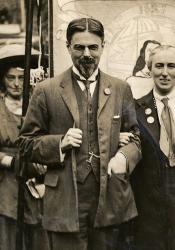Holloway Prison, London.
The movement for women’s suffrage took many forms and involved many different groups and societies. The National Union of Women’s suffrage Societies (NUWSS) campaigned peacefully and aided the movement by signing petitions and publishing pamphlets and newspapers. The women involved in peaceful actions were known as suffragists. Organizations such as the Women’s Social and Political Union (WSPU) and the Women’s Tax Resistance League (WTRL), resorted to more violent actions such as setting fires, vandalizing property, and hassling government officials. Women involved in the militant part of the Suffrage movement such as Clemence Housman, were called suffragettes. In 1910 Clemence joined the WTRL and participated in protests which called for members to withhold their tax payments until the right to vote was won. On Friday September 29th, 1911, Clemence was arrested outside of her Kensington home for purposefully resisting tax payment. Her arrest was supported by the suffrage community and she was later led by her brother, Laurence Housman, to the Holloway Prison in London. Clemence was released on October 6th and was hailed a suffragette martyr in the press.
Sources Used:
https://editions.covecollective.org/chronologies/clemence-housman-imprisoned-tax-resistance
Coordinates
Longitude: -0.124173100000

